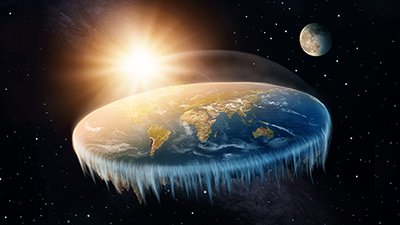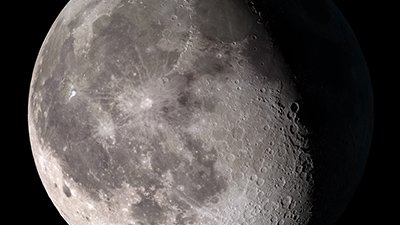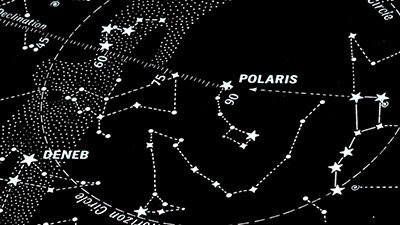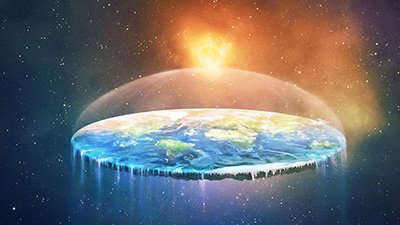Flat Earth
Most people have thought about the shape of the earth. From their earliest days in school, teachers and textbooks have taught students that the earth is spherical. For those who have given this some thought and have begun to raise simple objections to the earth’s spherical shape, it doesn’t take much to plant seeds of doubt. Often, people will respond with the observation that photos from space clearly show a spherical earth. However, we know that photos can easily be photoshopped or faked. And these types of photos and videos (starting with the Apollo space missions) have been available only for a little more than a half century. But evidences for a spherical earth go back much further than this.
Reasons We Know That the Earth Is Spherical
Earth’s Shadow
So how did people in the ancient world figure out that the earth is spherical? In the sixth century BC, Pythagoras taught that the earth was spherical, although none of his writings exist which explain how he came to this conclusion. Aristotle (384–322 BC) was among the first to write down the fact of our planet being a round sphere. He observed lunar eclipses and correctly realized that the cause of lunar eclipses (which can happen only with a full moon) is the shadow of the earth crawling across the moon. And because the edge of the earth’s shadow is always a portion of a circle, the earth’s shadow on the moon must also be a circle. If the earth were flat and round, like a disk, it could only cast a circular shadow for lunar eclipses that occur at midnight. For a lunar eclipse at sunrise or sunset, the earth’s shadow would be an ellipse, a line, or a rectangle. But during a lunar eclipse, the earth’s shadow is always a circle regardless of when the eclipse occurs. The only shape that consistently produces a circular shadow, regardless of its orientation, is a sphere. You can easily see this if you point a flashlight at a wall and use a circular dish and a ball. The dish will only project a circular shadow when oriented face-on to the light, and when it is edge on, or at any other angle, it will produce a line or ellipse.
Visibility of the Stars
The North Star is within a degree of the north celestial pole. As the earth rotates, the stars, sun, and moon appear to spin around the north celestial pole, so the north celestial pole remains fixed in the sky.
The altitude of the North Star is noticeably higher in the sky at northern locations than at southern locations. For example, the North Star is much higher in the sky in Minnesota than it is in Florida, as anyone who pays attention to the night sky on vacation can attest. This can happen only if north-south motion is along an arc. Furthermore, the North Star (Polaris) is not visible in locations more than one degree south of the equator, nor is the Southern Cross visible in most of the Northern Hemisphere. This makes no sense in a flat-earth model but comports perfectly with a spherical earth.
Curvature of the Earth
Not only is the earth curved in the north-south direction, it also is curved in the east-west direction, which is the reason why time zones were implemented. For example, there is a time difference of three hours between the east and west coasts of the United States (and 4–5 hours, respectively if Alaska and Hawaii are factored in). So the sun rises and sets approximately three hours earlier in Boston than it does in Los Angeles. This is easily verified by anyone who has flown between the east and west coasts of the United States. Not only will your watch (or phone) show that there is a time difference of three hours, but your body will notice the difference as well, which is what the term jetlag was invented to describe.
But before such rapid travel, how did people realize this? Dr. Danny Faulkner explains,
Such rapid transportation was not possible in ancient times, but the ancients could see this time difference another way. A lunar eclipse obviously must happen simultaneously for everyone on earth, but it will be different times at different locations. For instance, a lunar eclipse may start shortly after sunset in the eastern Mediterranean, such as in Greece. However, in the western Mediterranean, such as in Spain, the moon would already be in eclipse when it rose that night. This means that the lunar eclipse began before sunset/moonrise in Spain but after sunset/moonrise in Greece. Communication was such in the ancient world that people were aware of this effect. This shows that the earth is curved in the east-west direction. If the earth is curved in both the north-south and east-west directions, the most likely shape of the earth is a sphere.
Ancient Sources
Pliny the Elder also noticed and recorded that the hulls of ships disappeared before their masts did as ships sailed away. This would happen only if the earth was spherical. Without precise optical aids, this is often difficult to see. However, a related effect is that someone perched atop the mast of the ship in a crow’s nest high above a ship’s deck can spot land or other ships before people on the deck can. If the earth were flat, there would be no advantage to being in a crow’s nest, as you should be able to see all land and ships from the deck.
A similar thing can be observed on land. On the eastern shore of Green Bay, Wisconsin, is the Door Peninsula. The distance across Green Bay to Northern Michigan is more than 20 miles. If you stand on the beach at Green Bay, you cannot see Northern Michigan. However, if you climb the bluffs above the beach, you are able to see the shoreline of Northern Michigan. This is possible only if the earth is spherical.
“Support” for a Flat Earth
Most of the supposed flat earth “evidences” are negative; they are attempts to “prove” that the earth is not spherical. However, the Bedford Level Experiment is a positive “evidence”—an attempt to directly show that the earth is flat. In 1838, Samuel Rowbotham claimed to have conducted an experiment on the Old Bedford River near Norfolk, England. The Bedford Level is a six-mile stretch of the river that is straight, allowing an uninterrupted view along the six miles. Furthermore, there is no gradient there, so that portion of the river slowly flows like a drainage canal.
Rowbotham waded into the river to observe a rowboat with a five-foot-high mast row away, using a telescope held eight inches above the water. Rowbotham claimed that he could see the mast when it was six miles away, even though the spherical earth required that the top of the mast be about 11 feet below his horizon (as viewed from 8 inches above the water). Rowbotham therefore concluded that the earth must be flat. Rowbotham used the pseudonym “Parallax” to publish his results in a pamphlet titled Zetetic Astronomy in 1849, which he expanded into a book in 1865.
In 1870, John Hampden, another flat-earth proponent, offered a significant wager to anyone who could demonstrate a convex curvature of a large body of water, as a spherical earth would require. Alfred Russell Wallace took the challenge but was apparently aware of Rowbotham’s methodologies and erroneous result. Wallace altered the technique a bit to avoid the known effects of refraction. He placed two identical objects at different locations along the Bedford Level. Wallace examined each object from a telescope mounted on a bridge. He found that the nearer object appeared higher than the more distant one, consistent with the results predicted by a spherical earth, as the density of air decreases with increasing height. This causes a slight change in the index of refraction in air: rays of light passing close to the earth’s surface are bent downward. This makes distant objects appear higher than they actually are when viewed from close to the earth’s surface.
What Has the Church Historically Taught About the Shape of the Earth?
Contrary to the common misconception, the medieval church did not believe or teach that the earth was flat. Thomas Aquinas (1225–1274 AD) introduced Aristotelian thought into medieval church teaching. Aristotle (fourth century BC) and subsequent Greek philosophers and mathematicians clearly taught that the earth was spherical. In the early second century BC, Eratosthenes measured the circumference of the spherical earth to a very close approximation. The works of Aristotle, Eratosthenes, and other scholars’ written works were all copied by monks and were widely available and discussed in the late medieval period by clergymen and well-educated people, and this continued through the transition to the Renaissance. Given the clear testimony of historical record, why is it so commonly believed by many people today (and ironically even by some in the church) that the church taught the earth was flat?
This misconception is easily traced to two late nineteenth-century skeptics, John William Draper and Andrew Dickson White, who invented the conflict thesis. The conflict thesis (a humanist tenet) holds that religion in general, and Christianity in particular, held back progress. The contention of the conflict thesis was that the alleged Dark Ages (fifth–fourteenth centuries) was a period when Europe was gripped with superstition (unfairly blamed solely on Christianity) that prevented intellectual advancement, and it was only after man’s reason (secular humanism) reasserted itself during the Renaissance that man slowly became unshackled from religious dogma, bringing about the Enlightenment.
The promoters of the conflict thesis also mythologized the story of Christopher Columbus. Many people even today believe that at the time of Columbus, nearly everyone thought the earth was flat. According to this false history, Columbus was one of the few people who thought the earth was spherical, and he understood that on a spherical earth one could sail westward from Europe to reach India and China. Supposedly, Columbus had to argue against strong objections from those who thought that the earth was flat in order to get support for his expedition (a complete and utter fabrication of the facts). Once Columbus managed to complete a voyage to the New World and returned to Europe, people supposedly realized that Columbus was right all along—the world was round and not flat.
But in reality, the opposition to his proposed journey was not the question of how possible it was to reach Asia by going westward but rather of how feasible (and logical) it was. The belief was that the westward voyage across the Atlantic between Europe and Asia was vast, with little or no land in between. At the time of Columbus, voyages over open water were very risky, and ships typically sailed no more than three days out of sight of land. A voyage westward across the Atlantic Ocean (presumably to Asia) would have required months, with no opportunity to resupply or be rescued along the way if problems developed.
It was known at the time how long it took to sail from Spain to the Orient by hugging the coast of Africa, rounding the Cape of Good Hope, and sailing up Eastern Africa and then past India. Keep in mind that the Suez Canal was not yet in existence. But going to the Orient via the Atlantic Ocean would be much longer since the Panama Canal did not exist at that time. For Columbus to have made it to China, he would have had to sail across the open Atlantic, circumvent South America and traverse the much vaster Pacific Ocean. And even though maps at that time were more crude and less accurate, most educated people knew that the distance was much greater by going west to the Orient.
The facts of history refute the commonly held story about Columbus. Much of the work supporting a flat earth today uncritically repeats and builds upon this false view. The flat-earth movement began in the mid-nineteenth century, the same time that the conflict thesis was being developed. While skeptics were ridiculing the Bible for allegedly teaching that the earth is flat, early flat-earthers foolishly accepted this false claim. Undoubtedly, the recent surge of interest in a flat earth among Christians has been fueled by the (false) belief that the Bible teaches that the earth is flat. But examining the Scriptures to see what they say, we find that promoters of a flat earth do not handle the text any better than they handle history.
Does the Bible Teach That the Earth Has an Edge?
Everyone understands that a sphere does not have an edge. Indeed, we can travel indefinitely around a sphere and never reach a boundary (and not have to worry about “falling off”). On the other hand, if the earth were flat, it must have an edge somewhere. However, Bible skeptics are fond of pointing out the phrase “four corners of the earth” (when not applying to a physical object like the ark of the covenant or an altar), though it appears only four times in the Bible (Isaiah 11:12; Ezekiel 7:2; Revelation 7:1, 20:8). Surely, the skeptics claim, this must refer to a flat, square earth—thus proving that the Bible teaches a flat earth. But contextually, those references point to cardinal directions and could just as easily have been translated “from the north, south, east and west.”
Biblical critics allege that this shows that the Bible writers believed one of the flat-earth cosmologies of the ancient world, thus proving that the Bible is not inspired but rather that the people who wrote the Bible merely reflected the worldview of their times. There are some examples of flat-earth cosmologies from the ancient world, but they always consisted of a flat, round earth. A circle was considered a much more perfect shape than a square, so none of the ancient flat-earth cosmologies involved a square earth. If a square, flat earth were the cosmology of the Bible, then it would have been at odds with every other ancient flat-earth cosmology. Therefore, this attempt by skeptics to claim that the Bible teaches a flat earth does not square (pun intended) with the facts of history.
If the Verses That Mention the Earth’s Four Corners Do Not Refer to a Flat Earth, Then to What Do They Refer?
Let’s begin with Revelation 7:1, which speaks of four angels standing on the four corners of the earth and restraining the four winds of the earth. Even the most ardent students of hyperliteral interpretation of the Bible acknowledge the frequent poetic elements and use of imagery in the book of Revelation.
The four winds refer to the four cardinal directions from which winds can come: north, south, east, and west. We often use this nomenclature today, such as saying that the wind is “out of the west.” The repetition of the number four (“four angels . . . four corners . . . four winds”) ties each angel and each corner with one of the four compass directions.
The phrase “four corners of the earth” probably was an idiom in the Apostle John’s time, much as it is in English today, referring to every distant location on the earth. This is the meaning from the context of Revelation 20:7–8, the other occurrence of the phrase “four corners of the earth” in Revelation. It is probable that the English idiomatic understanding of “the four corners of the earth,” referring to the remotest parts of the earth, stems from these verses and from Isaiah 11:12, the third appearance of this phrase in the Bible. Its use there is generally understood to be idiomatic. And the Ezekiel 7:2 reference is strictly speaking of the “four corners” of the divided kingdom of Israel which in no way supports a flat earth.
Why the “Four Corners” Argument Is Rarely Used by Flat-Earthers?
While some promoters of a flat earth use these three verses, many do not. Why? They probably recognize that a square earth with corners does not agree with their model of a round, flat earth. This is a notable problem. How would Christians who believe in a flat earth because they earnestly believe that is what the Bible teaches handle these three verses?
Another oft-cited example, the phrase “ends of the earth” appears 28 times in the King James Version, and, if taken literally, propose that the earth has an edge, which would rule out a spherical earth. In their respective contexts, each of these 28 instances of the phrase “ends of the earth” shows that this phrase is also an idiomatic expression. This phrase often is used to speak of the people who inhabit these remote places, not of the distant parts of the earth itself (e.g., Psalm 67:7, 98:3; Isaiah 45:22). It is a poor argument that this phrase indicates that the earth is flat and has a physical edge.
Is the Firmament a Dome over the Earth?
Flat-earth cosmology holds that a dome covers a circular, flat earth, with its edge resting on the earth beyond the ice wall of Antarctica, that the stars are affixed to this dome, while the sun and moon are above the earth but beneath the dome. Some have called this a “snow-globe cosmology” because of its resemblance to a snow globe. Flat-earthers claim that this is the cosmology that the Bible teaches. Let us examine the scriptures that supposedly support this cosmology.
Dr. Danny Faulkner notes,
Key in this discussion is the firmament. The Hebrew word rāqîa‘ is translated as firmament in the King James Version. It appears a total of 17 times in the Old Testament, with over half of the occurrences (9) in chapter 1 of Genesis alone. The word is a noun that derives from the Hebrew root rq‘, meaning to stamp out. An example of this action is to stamp or pound a metal into thin sheets…
Unfortunately, some people reason that since this is an action frequently done to a metal, the thing being stretched out must have some physical property common with metals. Metals often are hard, so, according to this reasoning, the rāqîa‘ must be hard. But it is questionable if the rāqîa‘ is something that is hard. It is more likely that the intended meaning of rāqîa‘ is related to the process of stamping out, not a physical property of the thing subjected to the process. The process has the effect of spreading out a substance [as in 2 Samuel 22:43] or possibly making the substance thin. This is why many more modern translations of the Bible render rāqîa‘ as expanse rather than firmament.
From this brief glimpse at several Old Testament passages, there is no clear evidence that the rāqîa‘ is a solid dome over the earth. Rather, it likely is what we today would call much of the earth’s atmosphere as well as outer space.
Conclusion
It is a common belief today that the cosmology presented in the Bible is that of a hard dome over a flat earth supported by the “pillars of the earth” (as mentioned in 1 Samuel 2:8 and implied in Job 9:6). But ironically, proponents of flat earth never discuss Job 26:11, which mentions the pillars of heaven (if literal, they would have to go from the earth up to the “dome”). Nor do they mention Job 26:7, which states God “hangs the earth on nothing.” They are careful to pick and choose which Bible verses they use to support their position and ignore ones that don’t.
Compounding the problem, Christians who endorse a flat earth use depictions by contemporary theologians who wrongly portray biblical cosmology as a flat earth under a domed vault as evidence of what the Bible teaches. In doing so, they are supporting skeptics who attack the Bible by saying it endorses ANE (ancient near east) mythologies, thus subjugating biblical authority to other texts. Additionally, they become unwitting victims of the conflict thesis twice, first in believing in a flat earth and second in accepting the false domed-vault cosmology. This concept of biblical cosmology did not come from ANE sources but rather arose in the late nineteenth century as an attempt to discredit the Bible. Those who support the flat earth, believing that this is what the Bible teaches, have fallen into a trap. Ironically, while some flat-earthers believe they are defending the Bible, they have been tricked into doing just the opposite, using the same false arguments that skeptics use to cast doubt and ridicule Scripture.
Articles About Flat Earth
-
Feb. 11, 2024 from Answers Magazine
A resurgent flat-earth movement claims we need to get back to what the Bible says—but what does God’s Word really say about the earth’s shape?
-
Sept. 15, 2023 from Answers in Depth
Flat-Earthers Misunderstand Simplifying Assumptions
-
Sept. 14, 2023 from Danny Faulkner Blog
Another Chance to View the Creator’s Artistry
-
Aug. 30, 2023 from Danny Faulkner Blog
The Recent Lunar Occultation of Antares Disproves a Flat-Earth Claim.
-
Aug. 8, 2023 from Danny Faulkner Blog
One of the best meteor showers of the year will be this Sunday!
-
June 14, 2023 from Danny Faulkner Blog
Is the sun like a spotlight?
-
April 7, 2023 from Ken Ham Blog
Do people actually believe in a flat earth? Yes, there are people today, including a number of Christians, who actually do believe in a flat earth.
-
Dec. 21, 2022 from Danny Faulkner Blog
The misunderstanding some prominent flat-earthers is not limited to wave-particle duality. There are also fundamental misunderstandings about Einsteinian relativity theory.
-
Oct. 11, 2022 from Danny Faulkner Blog
There is a war going on between two groups of flat-earthers over the nature of light: is light a wave or a particle?
-
Aug. 25, 2022 from Danny Faulkner Blog
John Stunja has misled many flat-earthers through his teachings on the Coriolis effect, and does so again in a recent podcast.
-
May 31, 2022 from Answers in Depth
Flat-earthers falsely claim that Polaris remains motionless in the sky as all other stars circle it. However, appearances can be deceiving.
-
Oct. 8, 2021 from Danny Faulkner Blog
The use of real science leads to the conclusion that the earth is a globe. Since this contradicts the flat-earth religion, flat-earthers must discredit science.
-
June 10, 2021 from Danny Faulkner Blog
I rarely can make these observations, but when I do, I always get results that are consistent with the earth being a globe.
-
May 27, 2021 from Danny Faulkner Blog
Nathan Thompson, a prominent flat-earther that I’ve previously discussed, recently made a video where he claims to have proven a flat earth.
-
Feb. 26, 2021 from Danny Faulkner Blog
To many flat-earthers, believing in the flat earth is either equivalent to, or nearly on the level of, the gospel, and thus they promote it religiously.
-
Feb. 12, 2021 from Danny Faulkner Blog
It is as nearly as difficult to find pro-flat-earth material on the internet as it was to find anti-flat-earth material five years ago. What changed?
-
Feb. 5, 2021 from Danny Faulkner Blog
The black swan photo and other similar images are used to commit the informal fallacy of cherry-picking data.
-
Jan. 25, 2021 from Danny Faulkner Blog
How flat earthers cannot accurately account for the December solstice or other celestial phenomena with their zetetic model of the earth.
-
Dec. 18, 2020 from Danny Faulkner Blog
At the time of Eratosthenes, it was generally known that the earth is a globe. Eratosthenes built on that knowledge to measure the its circumference and radius.
-
Nov. 17, 2020 from Danny Faulkner Blog
The very inaccurate manner with which flat-earthers handle the Coriolis effect and the Foucault pendulum is typical of those in the flat-earth movement.
-
Oct. 28, 2020 from Danny Faulkner Blog
Flat-earthers use their definition of the scientific method to exclude an observational approach to testing ideas, which leads them to conclude that astronomy is not a science.
-
Sept. 24, 2020 from Danny Faulkner Blog
Flat-earthers often respond to criticism that Bullinger, who wrote the definitive book on figures of speech in the Bible, was a flat-earther.
-
April 27, 2020 from Danny Faulkner Blog
If flat-earth Christians are genuine in their faith, it makes me wonder why they are evangelizing about flat earth rather than the gospel.
-
April 17, 2020 from Danny Faulkner Blog
I’ve been curious as to what flat-earthers think about COVID-19, so I’ve been monitoring flat-earth websites and YouTube channels for weeks.
-
March 18, 2020 from Danny Faulkner Blog
I recently read Christine Garwood’s 2007 book, Flat Earth: The History of an Infamous Idea. I remember hearing when it came out, but at the time, I saw little need to read it.
-
-
Jan. 31, 2020 from Danny Faulkner Blog
-
Dec. 11, 2019 from Danny Faulkner Blog
This year’s Flat Earth International Conference had a different flavor from the previous two. The theme for this meeting was “Finding the Creator in Creation.”
-
Sept. 15, 2019 from Ken Ham Blog
The question “Is the earth flat?” has become so popular that Dr. Faulkner wrote a book, Falling Flat, that’s now available for order.
-
Aug. 9, 2019 from Danny Faulkner Blog
Where did the anti-Semitism of the modern flat-earth movement come from?
-
Aug. 2, 2019 from Ken Ham Blog
It’s not just atheists arguing the Bible teaches a flat earth—it’s some Christians, too, who’ve fallen for it and believe that’s what it teaches. But does it?
-
June 22, 2019 from Danny Faulkner Blog
In preparation for the premiere of the documentary Faith on the Edge, I gathered my thoughts on the sociology of the flat-earth movement into 20 points.
-
Dec. 22, 2018 from Danny Faulkner Blog
Flat-earthers argue that since certain verses in Scripture speak of the stars falling, then the stars will literally fall.
-
Dec. 14, 2018 from Danny Faulkner Blog
On November 15–16, 2018, I attended the Second Flat Earth International Conference. Here I take the opportunity to blog about this year’s meeting.
-
Aug. 28, 2018 from Danny Faulkner Blog
Flat-earthers spend considerable time and effort attempting to debunk all things from NASA. In this article, I will take up two of their complaints.
-
March 11, 2018 from Answers in Depth
Some flat-earthers have appealed to the Book of Enoch to support their argument that the Bible teaches that the earth is flat.
-
Feb. 24, 2018 from Refuting Common Evolutionist Claims
The fact that some people in history believed the earth to be flat highlights the fallibility of man’s reasoning. Throughout history, scientists’ confident assertions have later been disproven.
-
Nov. 17, 2017 from Danny Faulkner Blog
Going to a meeting such as FEIC, hearing directly from recognized flat-earth experts, and networking with flat-earthers is a legitimate part of my research.
-
April 4, 2017 from Answers in Depth
In this article, I will examine many of the biblical passages that supposedly teach that the earth is flat, and I will show that in fact they do not.
-
BlogA Lunar Occultation: Another Test for the Flat EarthMarch 17, 2017 from Danny Faulkner Blog
I have written about the flat-earth craze that has become popular. To believe that the earth is flat, one must believe in many other odd things.
-
Jan. 16, 2017 from Answers in Depth
Here I wish to expand upon the phenomenon that caused Rowbotham’s experiment to go awry. Rowbotham was a victim of a superior mirage.
-
BlogFlat Earth-Star TrailsOct. 12, 2016 from Danny Faulkner Blog
Skiba noted the title of was “Is the Earth Flat?” and my “answer to that question was essentially, ‘The Earth is not flat and the Bible never said it was!’”
-
Contradictions: Hanging on Pillars of Nothing?April 9, 2016
Erik Lutz, AiG–US, explains why the Bible records both a statement that the earth is immovably set on pillars and that it is hanging on nothing.
-
They Think the Earth is Flat?Aug. 9, 2008 from News to Know
They’re a tiny minority of untrained, pseudoscientific hacks who buy into a disproven, centuries-old myth rather than accepting well-established modern science.
-
Getting To Be as Flat as the “Flat Earth” ArgumentApril 19, 2005
Dr. Wolfe declared to the TV audience, “To teach kids that creationism explains something about the world is no different than teaching them that the earth is flat.”
-
Semi-Technical Research PaperIs the ’Erets (Earth) Flat?Aug. 1, 2001, pp. 52–53
P. H. Seely responds to J. P. Holding’s criticism of his writings about a flat earth.

Answers in Genesis is an apologetics ministry, dedicated to helping Christians defend their faith and proclaim the good news of Jesus Christ.
- Customer Service 800.778.3390
- © 2024 Answers in Genesis






















